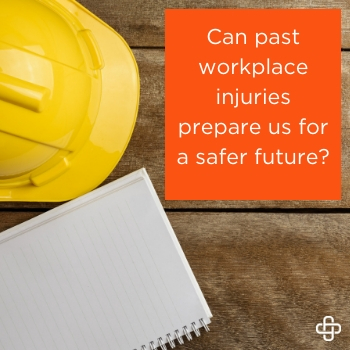
When it comes to safety in the workplace, there’s nothing more valuable than your greatest resource – your employees.
Read on to learn how the past injuries can prepare you for a safer future!
Examining Past Injuries For a Safer Future
Every place of business is unique, with unique safety concerns.
Workplace accidents that are common in your industry, may not be as prevalent in another. To prepare for a safer 2019, it’s important to take some time to evaluate the common injuries that have occurred within your company, and take the necessary steps to minimize it.
But, where do you begin?
Start here: identify safety vulnerabilities, and create an action plan to mitigate them.
By identifying what types of accidents are occurring most often in your organization (slip and falls, head injuries, cuts and lacerations?), you can assess their causes.
Is fatigue causing delayed judgment?
Are employees unaware of the safety protocol that’s in place?
Is dehydration or heat-related illness a factor?
Is ergonomics problems a contributor?
It could be that there’s one main culprit causing injury, or it could be a combination of many different factors. Whatever it may be, start the new year off right by focusing on education and implementation of a strong and supportive safety culture. Hold weekly toolbox talks centered around timely and relevant topics, and make sure you have an incident reporting program in place.
Future Goals for a Healthier and Safer Workplace
The best safety programs are the simplest to follow.
Here’s three top techniques to move your entire workforce in the safest direction, all year long!
1. Create a Safety Policy That Holds Everyone Accountable
Best practice safety standards are not just a manager responsibility – it’s the responsibility for your employees, too.
They’re on the front lines.
They’re executing the work on a daily basis.
If they aren’t working safety, the entire organization suffers. Review your existing safety policy, and make necessary changes to reflect actionable steps and attitude for accountability. Your policy should include:
- Clearly identified objectives of the safety program;
- Management’s commitment to protect the safety and health of each employee;
- Responsibilities of each employee;
- Who is responsible for the occupational health and safety programs;
- The overall safety and health philosophy of the organization; and
- Zero tolerance for unsafe behavior.
Require your employees to read, and sign the policy.
Assign a five-minute pow-wow between each employee and safety manager (or supervisor) to give them the space to ask any questions or concerns they may have. This way, everyone has the opportunity to get on board, and be held accountable for their actions moving forward in the new year!
2. Minimize Injury With Early Reporting
Early reporting is instrumental in optimizing injury outcome.
Let’s take a look at what happens when Bob the welder encounters a slip and fall.
Bob slips on the recently mopped floor on his way to lunch and twists his ankle. He doesn’t think he sprained it, and being the great team player he is, insists he can go back to work. Spending another five hours on the job that afternoon, he complains to his co-workers that the pain has gotten worse.
The next day he has to call in sick because he is no longer able to apply any weight on his right side.
By failing to report the injury and get an assessment of his injury right after it happened, his minor injury has now turned major – resulting in a trip to the ER and lost time.
3. Early Injury Intervention
A work culture that encourages early intervention – no matter how minor the incident may seem – can often result in first aid measures, and avoid the lost time trap.
No matter how well equipped and safe your employees are, injuries will take place. But the rate at which those injuries escalate lies in your hands.
How Do I Get Started With an Incident Case Management Program?
At Axiom Medical, we offer an incident case management program that’s composed of a team of in-house registered nurses 24/7 who are licensed in all 50 states to assess your injury within minutes after it occurs. In over 60 percent of the cases called in, our nurses can treat the injury at a first-aid level.
No matter how well equipped and safe your employees are, injuries will take place. But the rate at which those injuries escalate lies in your hands.
At Axiom Medical, we offer an injury management program that’s composed of a team of in-house registered nurses 24/7 who are licensed in all 50 states to assess your injury within minutes after it occurs.
In over 60 percent of the cases called in, our nurses can treat the injury at a first-aid level.
To learn more about how Axiom can help you, fill out the contact form or call us at +1 (877) 502-9466!

Heather lives and writes by the motto, “No coffee, no workee,” and is passionate about helping others live a happier and healthier life. When she’s not writing away, you can find her playing basketball with her two sons, planning her next getaway “somewhere tropical” or trying out a new recipe with chocolate as the main ingredient.
Find out more about our Injury Case Management services or our Occupational Health Programs.










